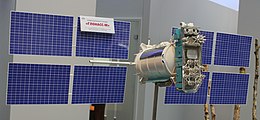Kosmos 2514: Difference between revisions
No edit summary |
|||
| (6 intermediate revisions by 5 users not shown) | |||
| Line 1: | Line 1: | ||
{{Short description|Russian military satellite}} |
|||
{{Infobox spaceflight|auto=all |
{{Infobox spaceflight|auto=all |
||
| name = Kosmos 2514 |
| name = Kosmos 2514 |
||
| Line 18: | Line 19: | ||
| launch_date = {{start-date|February 7, 2016, 00:21|timezone=yes}} UTC |
| launch_date = {{start-date|February 7, 2016, 00:21|timezone=yes}} UTC |
||
| launch_rocket = [[Soyuz-2 (rocket)|Soyuz-2.1b]]/[[Fregat]] |
| launch_rocket = [[Soyuz-2 (rocket)|Soyuz-2.1b]]/[[Fregat]]<ref name="rsw"/><ref name="sfn"/> |
||
| launch_site = [[Plesetsk Cosmodrome Site 43|Plesetsk 43/4]] |
| launch_site = [[Plesetsk Cosmodrome Site 43|Plesetsk 43/4]] |
||
| launch_contractor = Russian Aerospace Defence Forces |
| launch_contractor = Russian Aerospace Defence Forces |
||
| Line 39: | Line 40: | ||
}} |
}} |
||
'''Kosmos 2514''' ({{lang-ru|Космос 2514}} meaning ''Space 2514'') is a |
'''Kosmos 2514''' ({{lang-ru|Космос 2514}} meaning ''Space 2514'') is a Russian military [[satellite]] launched in 2016 as part of the [[GLONASS]] satellite navigation system. |
||
This satellite is a GLONASS-M satellite, also known as Uragan-M, and is numbered Uragan-M No. 751.<ref name="sfn"/> |
This satellite is a GLONASS-M satellite, also known as Uragan-M, and is numbered Uragan-M No. 751.<ref name="sfn"/> |
||
| Line 59: | Line 60: | ||
==References== |
==References== |
||
<references> |
<references> |
||
<ref name="n2yo">{{cite web|url=http://n2yo.com/satellite/?s=41330|title=LIVE REAL TIME SATELLITE TRACKING AND PREDICTIONS: COSMOS 2514 (GLONASS)|publisher=n2yo.com|date |
<ref name="n2yo">{{cite web|url=http://n2yo.com/satellite/?s=41330|title=LIVE REAL TIME SATELLITE TRACKING AND PREDICTIONS: COSMOS 2514 (GLONASS)|publisher=n2yo.com|access-date=March 13, 2016}}</ref> |
||
<ref name="rsw">{{cite web|url=http://www.russianspaceweb.com/uragan.html|title=GLONASS network|author=Anatoly Zak|publisher=RussiaSpaceWeb.com| |
<ref name="rsw">{{cite web|url=http://www.russianspaceweb.com/uragan.html|title=GLONASS network|author=Anatoly Zak|publisher=RussiaSpaceWeb.com|access-date=March 13, 2016}}</ref> |
||
<ref name="sfn">{{cite web|url=http://spaceflightnow.com/2016/02/07/glonass-navigation-system-reinforced-by-soyuz-launch/|title=Glonass navigation system reinforced by Soyuz launch|author=Stephen Clark|publisher=Spaceflight Now|date=February 7, 2016| |
<ref name="sfn">{{cite web|url=http://spaceflightnow.com/2016/02/07/glonass-navigation-system-reinforced-by-soyuz-launch/|title=Glonass navigation system reinforced by Soyuz launch|author=Stephen Clark|publisher=Spaceflight Now|date=February 7, 2016|access-date=March 13, 2016}}</ref> |
||
<ref name="GLONASS">{{cite web|url=http://www.glonass-ianc.rsa.ru/en/GLONASS/|title=GLONASS constellation status, 13.03.2016|publisher=Information-analytical centre, Korolyov, Russia|date=March 13, 2016| |
<ref name="GLONASS">{{cite web|url=http://www.glonass-ianc.rsa.ru/en/GLONASS/|title=GLONASS constellation status, 13.03.2016|publisher=Information-analytical centre, Korolyov, Russia|date=March 13, 2016|access-date=March 13, 2016|url-status=dead|archive-url=https://web.archive.org/web/20130504220156/http://www.glonass-ianc.rsa.ru/en/GLONASS/|archive-date=May 4, 2013}}</ref> |
||
</references> |
</references> |
||
| Line 69: | Line 70: | ||
[[Category:Spacecraft launched in 2016]] |
[[Category:Spacecraft launched in 2016]] |
||
[[Category:Spacecraft launched by Soyuz rockets]] |
[[Category:Spacecraft launched by Soyuz-2 rockets]] |
||
[[Category:Kosmos satellites]] |
[[Category:Kosmos satellites]] |
||
[[Category:2016 in Russia]] |
[[Category:2016 in Russia]] |
||
[[Category:GLONASS satellites]] |
|||
Latest revision as of 23:53, 20 August 2022
 Glonass-M satellite model | |
| Mission type | Navigation |
|---|---|
| Operator | Russian Aerospace Defence Forces |
| COSPAR ID | 2016-008A[1] |
| SATCAT no. | 41330[1] |
| Website | GLONASS status |
| Spacecraft properties | |
| Spacecraft | GLONASS No. 751 |
| Spacecraft type | Uragan-M |
| Manufacturer | Reshetnev ISS[2] |
| Launch mass | 1,414 kilograms (3,117 lb) [2] |
| Dry mass | 250 kg[2] |
| Dimensions | 1.3 metres (4 ft 3 in) diameter [2] |
| Start of mission | |
| Launch date | February 7, 2016, 00:21 UTC |
| Rocket | Soyuz-2.1b/Fregat[2][3] |
| Launch site | Plesetsk 43/4 |
| Contractor | Russian Aerospace Defence Forces |
| Orbital parameters | |
| Reference system | Geocentric |
| Regime | Medium Earth orbit |
| Semi-major axis | 25,508 km (15,850 mi)[1] |
| Eccentricity | 0.0010[1] |
| Perigee altitude | 19,164 km (11,908 mi)[1] |
| Apogee altitude | 19,111 km (11,875 mi)[1] |
| Inclination | 64.81 degrees[1] |
| Period | 675.7 minutes[1] |
| Epoch | 12 March 2016 |
Kosmos 2514 (Russian: Космос 2514 meaning Space 2514) is a Russian military satellite launched in 2016 as part of the GLONASS satellite navigation system.
This satellite is a GLONASS-M satellite, also known as Uragan-M, and is numbered Uragan-M No. 751.[3]
Kosmos 2514 was launched from Site 43/4 at Plesetsk Cosmodrome in northern Russia. A Soyuz-2-1b carrier rocket with a Fregat upper stage was used to perform the launch which took place at 00:21 UTC on 7 February 2016. The launch successfully placed the satellite into a Medium Earth orbit. It subsequently received its Kosmos designation, and the international designator 2016-008A. The United States Space Command assigned it the Satellite Catalog Number 41330.[1]
The satellite is in orbital plane 3, in orbital slot 17.[4] As of March 2016 it remains in operation.
See also
[edit]References
[edit]- ^ a b c d e f g h i "LIVE REAL TIME SATELLITE TRACKING AND PREDICTIONS: COSMOS 2514 (GLONASS)". n2yo.com. Retrieved March 13, 2016.
- ^ a b c d e Anatoly Zak. "GLONASS network". RussiaSpaceWeb.com. Retrieved March 13, 2016.
- ^ a b Stephen Clark (February 7, 2016). "Glonass navigation system reinforced by Soyuz launch". Spaceflight Now. Retrieved March 13, 2016.
- ^ "GLONASS constellation status, 13.03.2016". Information-analytical centre, Korolyov, Russia. March 13, 2016. Archived from the original on May 4, 2013. Retrieved March 13, 2016.
